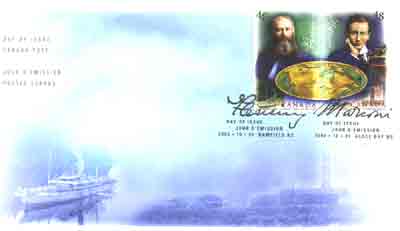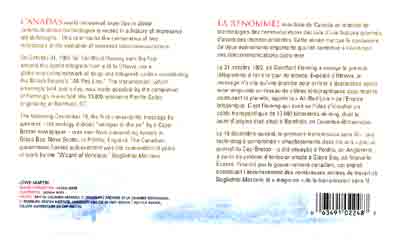The following stamps were kindly sent to us by the ex secretary to Sir Robert Telford, Pauline Easton, who had received them from a friend in Canada. She wished the stamps to be lodged in a safe and appropriate place.
The envelope shown here, together with a sheet of the unused stamps, will be placed in the care of Chelmsford Museums and held at Sandford Mill. The Mill also holds many other Marconi related artefacts.
Sandford Mill is not open on a daily basis but holds several open days throughout the year. For more details phone +44 1245 475498 or view the web site at http://www.chelmsford.gov.uk/museums/engine.htm During these open days the stamps and other items can be viewed on request.


Larger versions of these images can be viewed at the gallery www.marconi-veterans.org/gallery/
The text of the inscription on the reverse of the envelope is reproduced below
English on the left column
CANADA’S world-renowned expertise in global communications technologies is rooted in a history of impressive breakthroughs. This year marks the centenaries of two milestones in the evolution of overseas telecommunications.
On October 31, 1902, Sir Sandford Fleming sent the first around-the-world telegram from and to Ottawa, via a globe-encircling network of deep-sea telegraph cables constituting the British Empire’s “All-Red Line.” The transmission, which amazingly took just a day, was made possible by the completion of Fleming’s brainchild, the 13,000-kilometre Pacific Cable originating at Bamfield, BC.
The following December 15, the first transatlantic message by wireless – technology dubbed “whisper in the air” by a Cape Breton newspaper – was sent from transmitting towers in Glace Bay, Nova Scotia, to Poldhu, England. The Canadian government-funded achievement was the culmination of years of work by the “Wizard of Wireless,” Guglielmo Marconi.
French on the right column
LA RENOMMÉE mondiale du Canada en matière de technologies des communications découle d’une histoire jalonnée d’avancées impressionnantes. Cette année marque le centenaire de deux événements importants qui ont contribue à l’évolution des télécommunications outre-mer.
Le 31 octobre 1902, sir Sandford Fleming a envoyé le premier télégramme a faire le tour du monde. Expédié d’Ottawa, le message n’a mis qu’une journée pour arriver à destination après avoir emprunté un réseau de câbles télégraphiques sous-marins ceinturant la planète, appelé la « All-Red Line » de l’Empire britannique. C’est Fleming qui avait eu I’idée d’installer un câble transpacifique de 13 000 kilomètres de long, dont le point d’origine était situé à Bamfield, en Colombia-Britannique.
Le 15 décembre suivant, la première transmission sans fil – une technologie surnommée « chuchotements dans les airs » par un journal du Cap-Breton – a été envoyée à Poldhu, en Angleterre, à partir de pylônes d’émission situés à Glace Bay, en Nouvelle-Écosse. Financé par le gouvernement canadien, cet exploit constituait I’aboutissement des nombreuses années de travail de Guglielmo Marconi, le « magicien » de la transmission sans fil.
LOWE-MARTIN
DESIGN / CONCEPTION: SUSAN WARR
ILLUSTRATION : BONNIE ROSS
PHOTOS : BRITISH COLUMBIA ARCHIVES. C. BRADBURY / ARCHIVES DE LA COLOMBIE-BRITANNIQUE, C. BRADBURY, BEATON INSTITUTE, UNIVERSITY COLLEGE OF CAPE BRETON / INSTITUT BEATON, COLLEGE UNIVERSITAIRE DU CAP-BRETON
